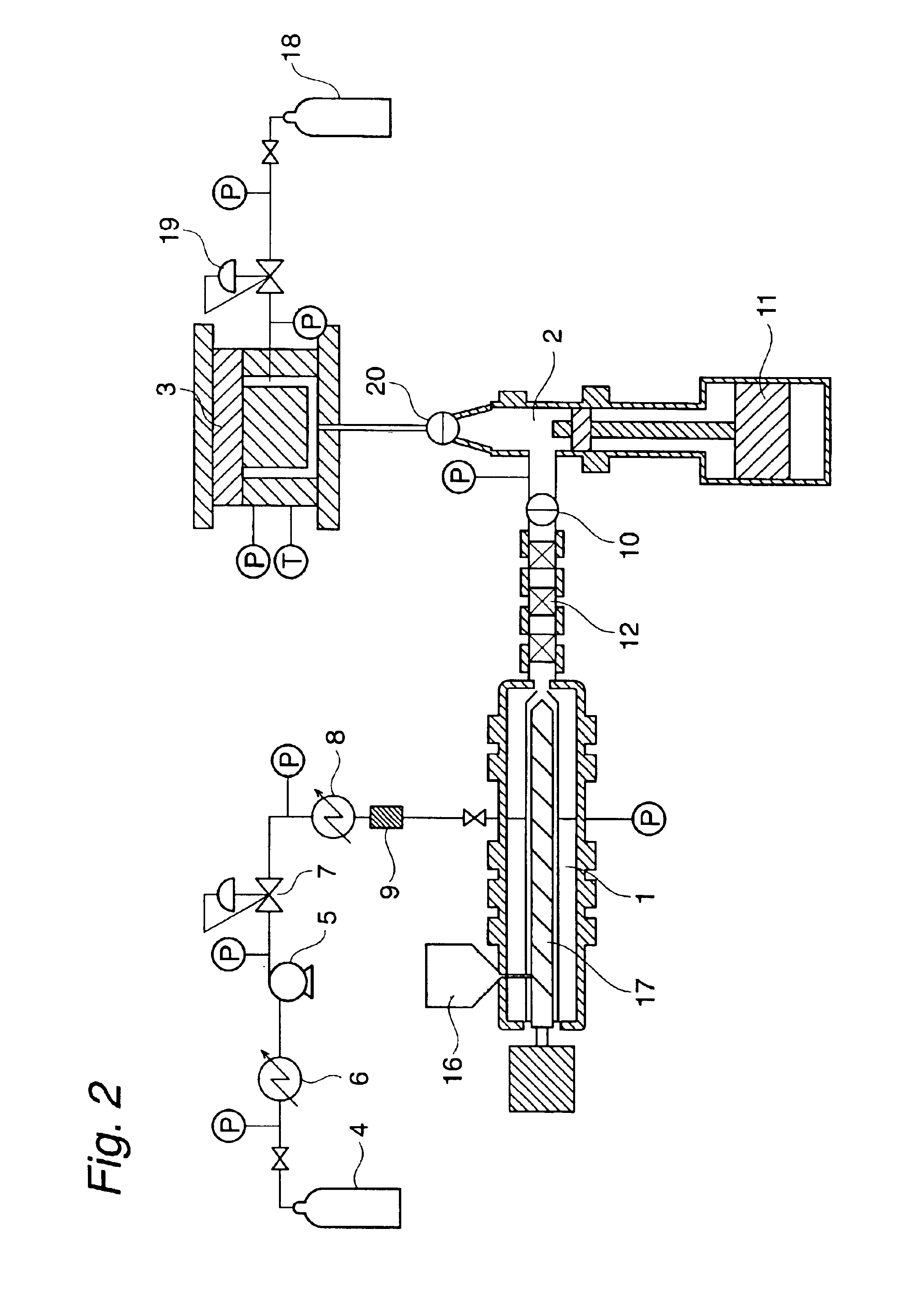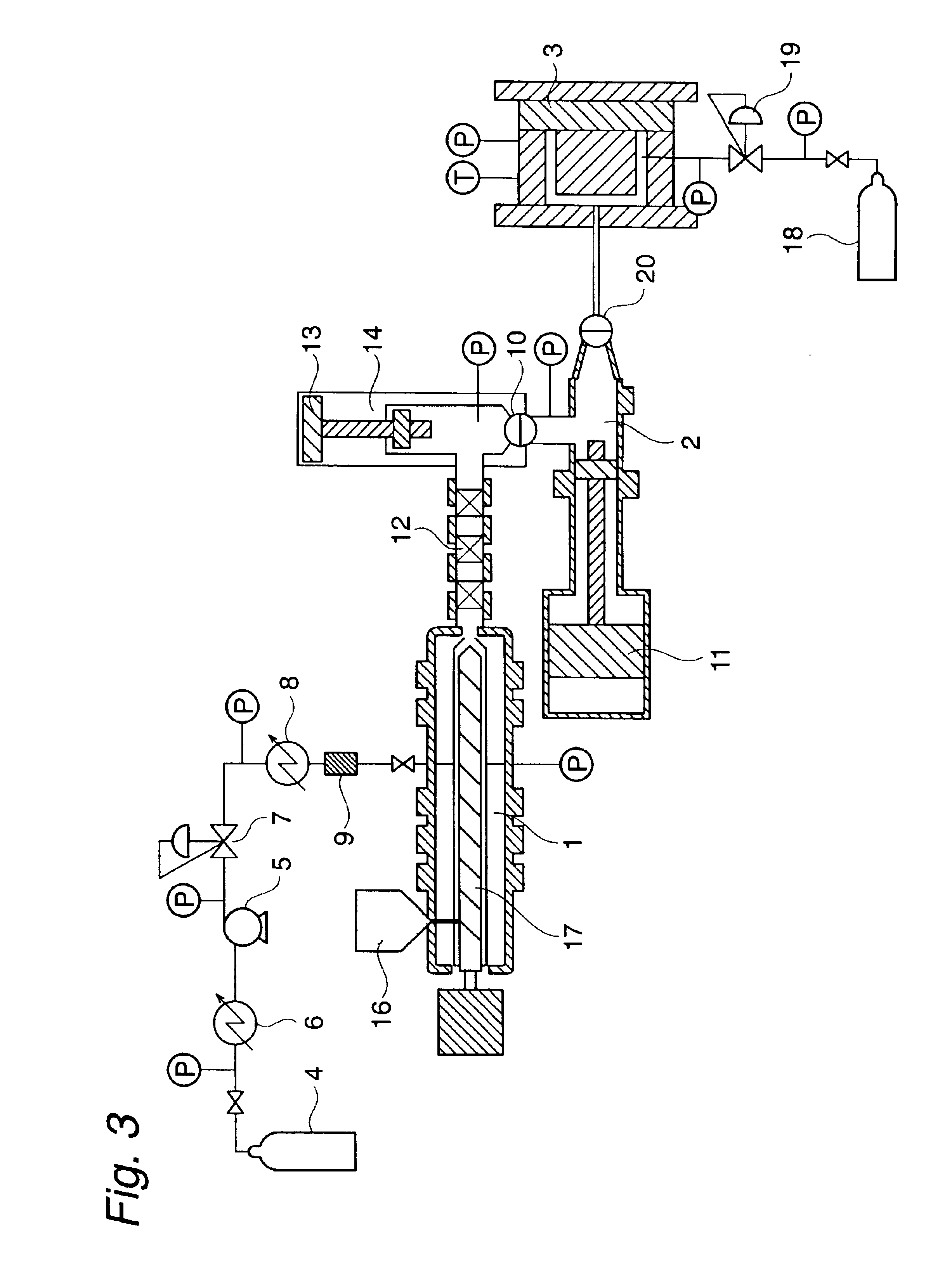Foam of thermoplastic urethane elastomer composition and process for producing the foam
a technology of thermoplastic urethane and composition, which is applied in the field of urethane-based thermoplastic elastomer composition foam, which can solve the problems of difficult to produce foams with a high molecular weight, and the foam produced by this method does not provide soft cushioning characteristics, etc., and achieves excellent flexibility and mechanical properties, excellent surface conditions and outer appearances. , the effect of forming the composition smoothly
- Summary
- Abstract
- Description
- Claims
- Application Information
AI Technical Summary
Benefits of technology
Problems solved by technology
Method used
Image
Examples
example 1
In Example 1, the apparatus shown in FIG. 1 in this specification was used. The carbon dioxide supply part was provided at around the center of the resin plasticizing cylinder (1). The urethane-based thermoplastic elastomer used was Pellethane 2103-9OAEL (Dow Chemical's trade name), which was dried at 110° C. for 4 hours. It had a melt flow rate of 0.7 g / 10 minutes (determined in accordance with ASTM D-1238-65T at 190° C. and a load of 2.16 kg), melting temperature of 166° C. (determined by DSC), crystallization heat of 11.6 J / g, and contained 0.095 mmol / g of the allophanate group (determined by the back titration, based on the amine decomposition method). This elastomer may be hereinafter referred to as TPU-1.
The urethane-based thermoplastic elastomer was charged, via the hopper (16), in the resin plasticizing cylinder (1), where it was molten under heating at 230° C.
Carbon dioxide was contained in a siphon type liquefied carbon dioxide cylinder (4), from which carbon dioxide could...
example 2
The foam was obtained in the same manner as in Example 1, except that the urethane-based thermoplastic elastomer was replaced by Pellethane 2355-80AE (Dow Chemical's trade name) having a melt flow rate of 2.7 g / 10 minutes (determined in accordance with ASTM D-1238-65T at 190° C. and a load of 2.16 kg) and crystallization heat of 10.8 J / g (this elastomer maybe hereinafter referred to as TPU-2) was used at 100 parts by weight and liquefied carbon dioxide at 2 parts by weight.
The evaluation results of the obtained foam are given in Table 1. It was the foam excellent in flexibility, heat resistance and surface appearances.
example 3
The foam was obtained in the same manner as in Example 1, except that the urethane-based thermoplastic elastomer was replaced by Pellethane 2363-80AE (Dow Chemical's trade name) having a melt flow rate of 4. 1 g / 10 minutes (determined in accordance with ASTM D-1238-65T at 190° C. and a load of 2.16 kg) and crystallization heat of 7.3 J / g (this elastomer may be hereinafter referred to as TPU-3), which was used with liquefied carbon dioxide at 3 parts by weight per the TPU-3.
The plate of the urethane-based thermoplastic elastomer foam (60×60×12 mm in size) was obtained in the same manner as in Example 1, except that the core in the mold (3) was moved back by 10 mm and expansion ratio was set at around 6.
The evaluation results of the obtained foam are given in Table 1. It was the foam excellent in flexibility, heat resistance and surface appearances.
PUM
| Property | Measurement | Unit |
|---|---|---|
| temperature | aaaaa | aaaaa |
| temperature | aaaaa | aaaaa |
| temperature | aaaaa | aaaaa |
Abstract
Description
Claims
Application Information
 Login to View More
Login to View More - R&D
- Intellectual Property
- Life Sciences
- Materials
- Tech Scout
- Unparalleled Data Quality
- Higher Quality Content
- 60% Fewer Hallucinations
Browse by: Latest US Patents, China's latest patents, Technical Efficacy Thesaurus, Application Domain, Technology Topic, Popular Technical Reports.
© 2025 PatSnap. All rights reserved.Legal|Privacy policy|Modern Slavery Act Transparency Statement|Sitemap|About US| Contact US: help@patsnap.com



